Geology of the Epicentral Area of the November 23, 1980 Earthquake (Irpinia, Italy): New Stratigraphical, Structural and Petrological Constrains
Abstract
1. Introduction
2. Geological Setting
- Apenninic carbonate Platform: this is an isolated platform bank between the oceanic realm of the Lucanian Ocean, to the west, and the deep-marine Lagonegro-Molise basin, to the east; this platform consists of thick, shallow-marine carbonate strata from the Late Triassic to early Miocene. The mostly continuous Mesozoic succession is formed by carbonate deposits related to a carbonate platform and its margins [57,58,59] with several evidences of platform emersion or drowning during Cretaceous. Main tectonic units are Alburno-Cervati, Mt. Picentini, Mt. Marzano, Mt. Maddalena, Mt. Croce units.
- Lagonegro-Molise Basin: this is located eastward of the carbonate platform and characterized by three different sectors, i.e., western, central, and eastern ones [29,60]. The Lagonegro II [61,62], Monte Arioso [29], Frigento [26], and Sannio [27,55,60] units refer to the internal, western portions of the basin; they are formed by calciclastic deposits produced by the erosion of the western margin of the Apenninic platform, interbedded with hemipelagic clays and marls. The Lagonegro I [61,62], Groppa d’Anzi [29], and Fortore [54,55,60] units refer to the axial sector of the basin and are formed by cherty calcareous-mudstone sequences. The Campomaggiore, Daunia, and Vallone del Toro units [27,63,64,65] refer to the eastern sectors and are characterized by clays and marls with calciclastic layers produced by erosion of the western margin of the Apulian platform.
- Numidian Sandstone, mostly formed by Langhian quartzarenites and conformable Serravallian post-Numidian successions, formed by mixed quartzofeldspathic sandstones and calciclastic arenaceous-pelitic beds (foreland depozones);
- Langhian to Tortonian San Giorgio Fm. and Serra Palazzo Fm., mostly composed of quartzofeldspatic sandstones and calciclastic arenaceous beds (foredeep depozone);
- Tortonian to Early Messinian, quartzose-feldspatic and partly sedimentary carbonatoclastic petrofacies, wedge-top successions (Gorgoglione, Castelvetere, and San Bartolomeo fms.);
- Late Messinian quartzolithic to quartzofeldspatic sandstones (Anzano Molasse and Tufo-Altavilla units; Crotone basin sequence), which can be referred to infilled wedge-top basins;
- Unconformity-bounded Pliocene quartzofeldspatic sandstone strata (wedge-top depozones), characterized by strong synsedimentary tectonic activity.
3. Methods
- (a)
- Quartz grains, including monocrystalline quartz grains (Qm), polycrystalline quartzose lithic fragments (Qp), and total quartzose grains (Qt = Qm + Qp);
- (b)
- Feldspar grains (F), including both plagioclase (P) and potassium feldspar (K);
- (c)
- Aphanitic lithic fragments (L), as the sum of volcanic/metavolcanic (Lv and Lvm), sedimentary (Ls) and metasedimentary (Lm; including Lsm as the sum of Ls and Lm). Carbonate lithic fragments have been reported in Ls (namely, extrabasinal carbonate grains [74,75,81]), because of their importance and occurrence in detrital modes of Apenninic sandstones;
- (d)
- Phaneritic and aphanitic rock/lithic fragments (R), recalculated by point-counting of specific assignment of Lm, Lv, Ls lithic fragments plus quartz, feldspar, micas, and dense minerals in coarse-grained polymineralic fragments in which these minerals individually are larger than the lower limit of the sand range (0.0625 mm), that during counting are summed as quartz (Qm) and feldspar (F) or micas or dense mineral grains (e.g., [69,73,74,75,78]).
4. Results
4.1. Geological Map: Stratigraphic Units and Structural Elements
4.2. Subsurface Data: Tunnel and Borehole Logs
4.3. Sandstone Petrology: Principal Compositional Groupings
4.3.1. Quartzolithic Sandstone Petrofacies
4.3.2. Quartzofeldspathic Sandstone Petrofacies
4.3.3. Hybrid Arenite and Quartzarenite Sandstone Petrofacies
5. Discussion
5.1. Geological Profile along Tunnel Pavoncelli Bis
5.2. Geology and Tectonic Evolution
6. Conclusions
Author Contributions
Funding
Acknowledgments
Conflicts of Interest
References
- Guidoboni, E.; Ferrari, G.; Mariotti, D.; Comastri, A.; Tarabusi, G.; Sgattoni, G.; Valensise, G. CFTI5Med, Catalogo dei Forti Terremoti in Italia (461 a.C.-1997) e nell’area Mediterranea (760 a.C.-1500); Istituto Nazionale di Geofisica e Vulcanologia: Roma, Italy, 2018; Available online: storing.ingv.it/cfti/cfti5/ (accessed on 18 June 2020).
- Locati, M.; Camassi, R.; Rovida, A.; Ercolani, E.; Bernardini, F.; Castelli, V.; Caracciolo, C.H.; Tertulliani, A.; Rossi, A.; Azzaro, R.; et al. Database Macrosismico Italiano (DBMI15), versione 2.0; Istituto Nazionale di Geofisica e Vulcanologia: Roma, Italy, 2019; Available online: emidius.mi.ingv.it/CPTI15-DBMI15/description_DBMI15.htm (accessed on 18 June 2020).
- Branno, A.; Esposito, E.; Luongo, G.; Marturano, A.; Porfido, S.; Rinaldis, V. The largest earthquakes of the Apennines, southern Italy. In Proceedings of the AIGI-IAEG Proceedings, Bari, Italy, 13–19 April 1986; Volume 4, pp. 3–14. [Google Scholar]
- Bernard, P.; Zollo, A. The Irpinia (Italy) 1980 earthquake: Detailed analysis of a complex normal faulting. J. Geophys. Res. 1989, 94, 1631–1648. [Google Scholar] [CrossRef]
- Valensise, G. Summary of Contributions on the 23 November 1980, Irpinia earthquake. Ann. di Geofis. 1993, 36, 345–351. [Google Scholar]
- Westaway, R.W.C.; Jackson, J.A. Surface faulting in the southern Italian Campania—Basilicata earthquake of 23 November 1980. Nature 1984, 312, 436–438. [Google Scholar] [CrossRef]
- Pingue, F.; De Natale, G. Fault mechanism of the 40 seconds subevent of the 1980 Irpinia (Southern Italy) earthquake from levelling data. Geophys. Res. Lett. 1993, 20, 911–914. [Google Scholar] [CrossRef]
- Porfido, S.; Alessio, G.; Gaudiosi, G.; Nappi, R.; Spiga, E. The resilience of some villages 36 years after the Irpinia-Basilicata (Southern Italy) 1980 earthquake. In Proc. 4th WLF2017, Advancing Culture of Living with Landslides; Mikošet, M., Casagli, N., Yin, Y., Sassa, K., Eds.; Springer: Cham, Switzerland, 2017; Volume 15. [Google Scholar]
- Cotecchia, V. Ground deformations and slope instability produced by the earthquake of 23 November 1980 in Campania and Basilicata. Geol. Appl. Idrogeol. 1986, 21, 31–100. [Google Scholar]
- Cotecchia, V.; Salvemini, A.; Ventrella, N.A. Interpretazione degli abbassamenti territoriali indotti dal terremoto del 23 Novembre 1980 e correlazioni con i danni osservati su talune strutture ingegneristiche dell’area epicentrale irpina. Riv. Ital. Geotec. 1990, 4, 145–158. [Google Scholar]
- Esposito, E.; Pece, R.; Porfido, S.; Tranfaglia, G. Hydrological anomalies connected to earthquakes in Southern Apennines (Italy). Nat. Hazards Earth Syst. Sci. 2001, 1, 137–144. [Google Scholar] [CrossRef]
- Porfido, S.; Esposito, E.; Michetti, A.M.; Blumetti, A.M.; Vittori, E.; Tranfaglia, G.; Guerrieri, L.; Ferreli, L.; Serva, L. Areal distribution of ground effects induced by strong earthquakes in the Southern Apennines (Italy). Surv. Geophys. 2002, 23, 529–562. [Google Scholar] [CrossRef]
- Gizzi, F.T.; Potenza, M.R.; Zotta, C. 23 November 1980 Irpinia–Basilicata earthquake (Southern Italy): Towards a full knowledge of the seismic effects. Bull. Earthq. Eng. 2012, 10, 1109–1131. [Google Scholar] [CrossRef]
- Galli, P.; Peronace, E. New paleoseismic data from the Irpinia fault. A different seismogenic perspective for southern Apennines (Italy). Earth Sci. Rev. 2014, 136, 175–201. [Google Scholar] [CrossRef]
- Galli, P.A.; Peronace, E.; Quadrio, B.; Esposito, G. Earthquake fingerprints along fault scarps: A case study of the Irpinia 1980 earthquake fault (southern Apennines). Geomorphology 2014, 206, 97–106. [Google Scholar] [CrossRef]
- Engineering Office. The Apulian Acqueduct, Southern Italy. Engineering 1929, 35–36. [Google Scholar]
- Servizio Geologico d’Italia. Carta Geologica d’Italia alla Scala 1:100.000, F° 186 «S. Angelo dè Lombardi», 1st ed.; Servizio Geologico d’Italia: Roma, Italy, 1970; Available online: http://193.206.192.231/carta_geologica_italia/tavoletta.php?foglio=186 (accessed on 9 May 2020).
- Servizio Geologico d’Italia. Carta Geologica d’Italia alla Scala 1:100.000, F° 198 «Eboli»; Servizio Geologico d’Italia: Roma, Italy, 1970; Available online: http://193.206.192.231/carta_geologica_italia/tavoletta.php?foglio=198 (accessed on 9 May 2020).
- Bonardi, G.; D’argenio, B.; Perrone, B. Carta geologica dell’Appennino meridionale. Mem. Soc. Geol. Ital. 1988, 41, 1341. [Google Scholar]
- ISPRA—Servizio Geologico d’Italia. Carta Geologica d’Italia Alla Scala 1:50000, Foglio 468 Eboli. Available online: www.isprambiente.gov.it/Media/carg/468_EBOLI/Foglio.html (accessed on 9 May 2020).
- ISPRA—Servizio Geologico d’Italia. Carta Geologica d’Italia Alla Scala 1:50000, Foglio 450 Sant’Angelo dei Lombardi. Available online: www.isprambiente.gov.it/Media/carg/450_SANTANGELOLOMBARDI/Foglio.html (accessed on 9 May 2020).
- Bonardi, G.; Ciarcia, S.; Di Nocera, S.; Matano, F.; Sgrosso, I.; Torre, M. Carta delle principali Unità Cinematiche dell’Appennino Meridionale. Nota illustrativa. Ital. J. Geosci. 2009, 128, 47–60. [Google Scholar]
- Matano, F.; Critelli, S.; Barone, M.; Muto, F.; Di Nocera, S. Stratigraphic and provenance evolution of the southern Apennines foreland basin system during the Middle Miocene to Pliocene (Irpinia-Sannio successions, Italy). Mar. Pet. Geol. 2014, 57, 652–670. [Google Scholar] [CrossRef]
- Postpischl, D.; Branno, A.; Esposito, E.; Ferrari, G.; Maturano, A.; Porfido, S.; Rinaldis, V.; Stucchi, M. The Irpinia earthquake of November 23; 1980. Atlas Isoseismal Maps Ital. Earthq. CNR-PFG 1985, 114, 152–157. [Google Scholar]
- Critelli, S. Provenance of Mesozoic to Cenozoic Circum-Mediterranean sandstones in relation to tectonic setting. Earth-Sci. Rev. 2018, 185, 624–648. [Google Scholar] [CrossRef]
- Di Nocera, S.; Matano, F.; Torre, M. Le unità “sannnitiche” Auct. (Appennino centromeridionale) rassegna delle correnti interpretazioni stratigrafiche e paleogeografiche e nuove ipotesi con l’introduzione dell’Unità di Frigento. St. Geol. Camerti 2002, 1, 87–102. [Google Scholar]
- Di Nocera, S.; Matano, F.; Pescatore, T.; Pinto, F.; Quarantiello, R.; Senatore, M.; Torre, M. Schema geologico del transetto Monti Picentini orientali—Monti della Daunia meridonali: Unità stratigrafiche ed evoluzione tettonica del settore esterno dell’Appennino meridionale. Boll. Soc. Geol. Ital. 2006, 125, 1–20. [Google Scholar]
- Mostardini, F.; Merlini, S. Appennino Centro-meridionale: Sezioni geologiche e proposta di modello strutturale. Mem. Della Soc. Geol. Ital. 1986, 35, 177–202. [Google Scholar]
- Pescatore, T.; Renda, P.; Tramutoli, M. Rapporti tra le Unità lagonegresi e l’Unità sicilide nella media valle del Basento. Mem. Soc. Geol. Ital. 1988, 41, 353–361. [Google Scholar]
- Ogniben, L. Schema introduttivo alla geologia del confine calabro-lucano. Mem. Soc. Geol. Ital. 1969, 8, 453–763. [Google Scholar]
- Critelli, S. Sandstone detrital modes in the Paleogene Liguride Complex, accretionary wedge of the Southern Apennines (Italy). J. Sediment. Petrol. 1993, 63, 464–476. [Google Scholar]
- Critelli, S. The interplay of lithospheric flexure and thrust accomodation in forming stratigraphic sequences in the southern Apennines foreland basin system, Italy. Mem. Dell’Accad. Naz. Dei Lincei 1999, 10, 257–326. [Google Scholar] [CrossRef]
- Critelli, S.; Muto, F.; Perri, F.; Tripodi, V. Interpreting Provenance Relations from Sandstone Detrital Modes, Southern Italy Foreland Region: Stratigraphic record of Miocene tectonic evolution. Mar. Pet. Geol. 2017, 87, 47–59. [Google Scholar] [CrossRef]
- Barone, M.; Critelli, S.; Le Pera, E.; Di Nocera, S.; Matano, F.; Torre, M. Stratigraphy and detrital modes of Upper Messinian Post-Evaporitic sandstones of the Southern Apennines, Italy: Evidence of foreland-basin evolution during the Messinian Mediterranean salinity crisis. Int. Geol. Rev. 2006, 48, 702–724. [Google Scholar] [CrossRef]
- Critelli, S.; Muto, F.; Tripodi, V.; Perri, F. Relationships between lithospheric flexure, thrust tectonics and stratigraphic sequences in foreland setting: The Southern Apennines foreland basin system, Italy. In New Frontiers in Tectonic Research at the Midst of Plate Convergence; Schattner, U., Ed.; Intech Open: London, UK, 2011; pp. 121–170. [Google Scholar]
- Critelli, S.; Muto, F.; Tripodi, V.; Perri, F. Link between thrust tectonics and sedimentation processes of stratigraphic sequences from the southern Apennines foreland basin system, Italy. Rend. Online Soc. Geol. Ital. 2013, 25, 21–42. [Google Scholar]
- Critelli, S.; Le Pera, E. Tectonic evolution of the Southern Apennines thrust-belt (Italy) as reflected in modal compositions of Cenozoic sandstone. J. Geol. 1995, 103, 95–105. [Google Scholar] [CrossRef]
- Critelli, S.; Le Pera, E. Post-Oligocene sediment dispersal systems and unroofing history of the Calabrian Microplate, Italy. Int. Geol. Rev. 1998, 48, 609–637. [Google Scholar] [CrossRef]
- Doglioni, C.; Harabaglia, P.; Martinelli, G.; Mongelli, F.; Zito, G. A geodynamic model of the southern Apennines accretionary prism. Terra Nova 1996, 8, 540–547. [Google Scholar] [CrossRef]
- Malinverno, A.; Ryan, W.B.F. Extension in the Tyrrhenian Sea and shortening in the Apennines as result of arc migration driven by sinking of the lithosphere. Tectonics 1986, 5, 227–245. [Google Scholar] [CrossRef]
- Patacca, E.; Scandone, P. Post-Tortonian mountain building in the Apennines. The role of the passive sinking of a relict lithospheric slab. In The Lithosphere in Italy. Advances in Earth Science Research; Boriani, A., Bonafede, M., Piccardo, G.B., Vai, G.B., Eds.; Accademia nazionale dei Lincei: Rome, Italy, 1989; Volume 80, pp. 157–176, Atti Conv. Lincei. [Google Scholar]
- Doglioni, C. A proposal for the kinematic modelling of W-dipping subduction possible applications to the Tyrrhenian-Apennines system. Terra Nova 1991, 3, 423–434. [Google Scholar] [CrossRef]
- Butler, R.W. Thrust sequences. J. Geol. Soc. 1987, 144, 619–634. [Google Scholar] [CrossRef]
- Selli, R. Sulla trasgressione del Miocene nell’Italia Meridionale. G. Geol. 1957, 26, 1–54. [Google Scholar]
- Selli, R. II Paleogene nel quadro della geologia dell’Italia centro meridionale. Mem. Soc. Geol. Ital. 1962, 3, 737–789. [Google Scholar]
- D’Argenio, B.; Pescatore, T.; Scandone, P. Structural pattern of the Campania-Lucania Apennines. In Structural model of Italy; Ogniben, L., Parotto, M., Praturlon, A., Eds.; Quaderni de La ricerca scientifica: Roma, Italy, 1975; Volume 90, pp. 313–327. [Google Scholar]
- D’Argenio, B.; Pescatore, T.; Scandone, P. Schema geologico dell’Appennini meridionale (Canpania, Lucania). Acc. Naz. Lincei Atti del Convegno Mod. Vedute Sulla Geol. Dell’Appennino. 1973, 182, 49–72. [Google Scholar]
- Sgrosso, I. Nuovi elementi per un più articolato modello paleogeografico nell’Appennino centro-meridionale. Mem. Soc. Geol. Ital. 1988, 41, 225–252. [Google Scholar]
- Sgrosso, I. Possibile evoluzione cinematica miocenica nell’orogene centro-sud appenninico. Boll. Soc. Geol. Ital. 1998, 117, 679–724. [Google Scholar]
- Patacca, E.; Scandone, P. Late thrust propagation and sedimentary response in the thrust-belt-foredeep system of the Southern Apennines (Pliocene-Pleistocene). In Anatomy of an Orogen: The Apennines and adjacent Mediterranean Basins; Vai, G.B., Martini, I.P., Eds.; Kluwer Academic Publ.: Berlin, Germany, 2001; pp. 401–440. [Google Scholar]
- Mazzoli, S.; Aldega, L.; Corrado, S.; Invernizzi, C.; Zattin, M. Pliocene-quaternary thrusting, syn-orogenic extension and tectonic exhumation in the Southern Apennines (Italy): Insights from the Monte Alpi area. Geol. Soc. Am. Sp. Pap. 2006, 414, 55–77. [Google Scholar]
- Mazzoli, S.; D’Errico, M.; Aldega, L.; Corrado, S.; Invernizzi, C.; Shiner, P.; Zattin, M. Tectonic burial and “young” (<10 Ma) exhumation in the southern Apennines fold and thrust belt (Italy). Geology 2008, 36, 243–246. [Google Scholar] [CrossRef]
- Mazzoli, S.; Ascione, A.; Buscher, J.T.; Pignalosa, A.; Valente, E.; Zattin, M. Low-angle normal faulting and focused exhumation associated with late Pliocene change in tectonic style in the southern Apennines (Italy). Tectonics 2014, 33, 1802–1818. [Google Scholar] [CrossRef]
- Pescatore, T.; Di Nocera, S.; Matano, F.; Pinto, F. L’Unità del Fortore nel quadro della geologia del settore orientale dei Monti del Sannio (Appennino meridionale). Boll. Soc. Geol. Ital. 2000, 119, 587–601. [Google Scholar]
- Pescatore, T.; Pinto, F.; Renda, P.; Senatore, M.R.; Tramutoli, M.; Valente, A. Avanfosse mioceniche dell’Appennino meridionale (Italia). Rend. Acc. Sc. Fis. Mat. Napoli 1996, 63, 85–121. [Google Scholar]
- Bonardi, G.; Amore, F.O.; Ciampo, G.; De Capoa, P.; Miconnet, P.; Perrone, V. II complesso Liguride auct.: Stato delle conoscenze e problemi aperti sulla sua evoluzione pre-appenninica ed i suoi rapporti con l’Arco Calabro. Mem. Soc. Geol. Ital. 1988, 41, 17–35. [Google Scholar]
- Carannante, G.; Severi, C.; Simone, L. Off-shelf carbonate transport along foramol (temperate-type) open shelf margins: An example from the Miocene of the central-southern Apennines (Italy). Mem. Soc. Geol. Fr. 1994, 169, 277–288. [Google Scholar]
- D’Argenio, B. Zone isopiche e faglie trascorrenti nell’Appennino meridionale. Mem. Soc. Geol. Ital. 1966, 4, 279–299. [Google Scholar]
- D’Argenio, B. Le piattaforme carbonatiche periadriatiche. Una rassegna di problemi nel quadro geodinamico mesozoico dell’area mediterranea. Mem. Soc. Geol. Ital. 1974, 13, 137–160. [Google Scholar]
- Dazzaro, L.; Di Nocera, S.; Pescatore, T.; Rapisardi, L.; Romeo, M.; Russo, B.; Senatore, M.R.; Torre, M. Geologia del margine della catena appenninica tra il F. Fortore ed il T.Calaggio (Monti della Daunia—App. Merid.). Mem. Soc. Geol. Ital. 1988, 41, 411–422. [Google Scholar]
- Scandone, P. Studi di geologia lucana: La serie calcareo-silico-marnosa e i suoi rapporti con l’Appennino calcareo. Boll. Soc. Nat. Napoli 1967, 76, 1–175. [Google Scholar]
- Scandone, P. Note illustrative della Carta Geologica d’Italia alla scala 1:100,000 dei Fogli 199 e 210, Potenza e Lauria. Serv. Geol. d’Ital. 1971, 71. Available online: http://sgi.isprambiente.it/geologia100k/mostra_pdf.aspx?pdffile=199.pdf (accessed on 9 May 2020).
- Basso, C.; Ciampo, G.; Ciarcia, S.; Di Nocera, S.; Matano, F.; Staiti, D.; Torre, M. Geologia del settore irpino-dauno dell’Appennino meridionale: Implicazioni sui domini paleogeografici delle unità bacinali meso-cenozoiche e nuovi vincoli stratigrafici nell’evoluzione tettonica mio-pliocenica del settore esterno della catena. Stud. Geol. Camerti 2002, 1, 7–26. [Google Scholar]
- Basso, C.; Di Nocera, S.; Matano, F.; Esposito, P.; Russo, B.; Torre, M. Stratigrafia delle successioni sedimentarie evaporitiche e post-evaporitiche del Messiniano superiore in Irpinia settentrionale (Appennino meridionale). Boll. Della Soc. Geol. Ital. 2001, 120, 211–231. [Google Scholar]
- Pescatore, T.; Senatore, M.R. A comparison between a present-day (Taranto Gulf) and Miocene (Irpinian basin) foredeep of the Southern Apennines (Italy). Spec. Publs Int. Ass. Sediment. 1986, 8, 169–182. [Google Scholar]
- Pavan, G.; Pirini, C. Stratigrafia del Foglio 157 «Monte, S. Angelo». Boll. Serv. Geol. d’Ital. 1966, 86, 123–189. [Google Scholar]
- Ricchetti, G.; Ciaranfi, N.; Luperto Sinni, E.; Mongelli, F.; Pieri, P. Geodinamica ed evoluzione sedimentaria e tettonica dell’avampaese apulo. Mem. Soc. Geol. Ital. 1988, 41, 57–82. [Google Scholar]
- Perri, F.; Critelli, S.; Cavalcante, F.; Mongelli, G.; Sonnino, M.; Dominici, R.; De Rosa, R. Provenance signatures for the Miocene volcaniclastic succession of the Tufiti di Tusa Formation, southern Apennines, Italy. Geol. Mag. 2012, 149, 423–442. [Google Scholar] [CrossRef]
- Critelli, S.; Le Pera, E. Detrital modes and Provenance of Miocene sandstones and Modern sands of the Southern Apennines thrust-top basins (Italy). J. Sediment. Rese. 1994, A64, 824–835. [Google Scholar] [CrossRef]
- Cavuoto, G.; Valente, A.; Nardi, G.; Martelli, L. Turbidite Depositional Systems and Architectures, Cilento, Italy. In The Atlas of Deep-Water Outcrops of the World; AAPG Special Publication, Studies in Geology: Tulsa, OK, USA, 2008; Volume 56. [Google Scholar]
- Zecchin, M.; Civile, D.; Caffau, M.; Muto, F.; Di Stefano, A.; Maniscalco, R.; Critelli, S. The Messinian succession of the Crotone Basin (southern Italy) I: Stratigraphic architecture reconstructed by seismic and well data. Mar. Pet. Geol. 2013, 48, 455–473. [Google Scholar] [CrossRef]
- Zecchin, M.; Caffau, M.; Di Stefano, A.; Maniscalco, R.; Lenaz, D.; Civile, D.; Muto, F.; Critelli, S. The Messinian succession of the Crotone Basin (southern Italy) II: Facies architecture and stratal surfaces across the Miocene-Pliocene boundary. Mar. Pet. Geol. 2013, 48, 474–492. [Google Scholar] [CrossRef]
- Ingersoll, R.V.; Bullard, T.F.; Ford, R.L.; Grimm, J.P.; Pickle, J.D.; Sares, S.W. The effect of grain size on detrital modes: A test of the Gazzi-Dickinson point-counting method. J. Sediment. Petrol. 1984, 54, 103–116. [Google Scholar]
- Zuffa, G.G. Optical analysis of arenites: Influence of methodology on compositional results. In Provenance of Arenites; Zuffa, G.G., Ed.; D. Reidel: Dordrecht, The Netherlands, 1985; pp. 165–189. [Google Scholar]
- Zuffa, G.G. Unravelling hinterland and offshore paleogeography from deep water arenites. In Deep-Marine Clastic Sedimentology: Concepts and Case Studies; Leggett, J.K., Zuffa, G.G., Eds.; Graham and Trotman: London, UK, 1987; pp. 39–61. [Google Scholar]
- Dickinson, W.R. Interpreting detrital modes of graywacke and arkose. J. Sediment. Petrol. 1970, 40, 695–707. [Google Scholar]
- Dickinson, W.R. Interpreting provenance relations from detrital modes of sandstones. In Provenance of Arenites; Zuffa, G.G., Ed.; D. Reidel: Dordrecht, The Netherlands, 1985; Volume 148, pp. 333–361. [Google Scholar]
- Critelli, S.; Ingersoll, R.V. Interpretation of neovolcanic versus palaeovolcanic sand grains: An example from Miocene deep-marine sandstone of the Topanga Group (southern California). Sedimentology 1995, 42, 783–804. [Google Scholar] [CrossRef]
- Caracciolo, L.; Critelli, S.; Innocenti, F.; Kolios, N.; Manetti, P. Unravelling provenance from Eocene-Oligocene sandstones of the Thrace Basin, North-east Greece. Sedimentology 2011, 58, 1988–2011. [Google Scholar] [CrossRef]
- Caracciolo, L.; Von Eynatten, H.; Tolosana-Delgado, R.; Critelli, S.; Manetti, P.; Marchev, P. Petrological, geochemical, and statistical analysis of Eocene-Oligocene sandstones of the Western Thrace Basin, Greece and Bulgaria. J. Sediment. Res. 2012, 82, 482–498. [Google Scholar] [CrossRef]
- Critelli, S.; Le Pera, E.; Galluzzo, F.; Milli, S.; Moscatelli, M.; Perrotta, S.; Santantonio, M. Interpreting siliciclastic-carbonate detrital modes in Foreland Basin Systems: An example from Upper Miocene arenites of the Central Apennines, Italy. In Sedimentary Provenance: Petrographic and Geochemical Perspectives; Arribas, J., Critelli, S., Johnsson, M., Eds.; Geological Society of America Special Paper: Boulder, CO, USA, 2007; Volume 420, pp. 107–133. [Google Scholar]
- Di Nocera, S.; Iannace, A.; Torre, M.; Basso, C.; Caiazzo, C.; Ciarcia, S.; Cinque, A.; Gasparrini, M.; Matano, F.; Mazzoli, S.; et al. Note Illustrative del Foglio 468 «Eboli». ISPRA—Servizio Geologico d’Italia, Note Illustrative della Carta Geologica d’Italia alla scala 1:50,000. Available online: www.isprambiente.gov.it/Media/carg/note_illustrative/468_Eboli.pdf (accessed on 9 May 2020).
- Pescatore, T.S.; Pinto, F. Note Illustrative del Foglio 450 «S. Angelo dei Lombardi». ISPRA—Servizio Geologico d’Italia, Note Illustrative della Carta Geologica d’Italia alla scala 1:50,000; 2016. Available online: www.isprambiente.gov.it/Media/carg/note_illustrative/450_SAngeloLombardi.pdf (accessed on 9 May 2020).
- Pescatore, T.S.; Di Nocera, S.; Matano, F.; Pinto, F.; Boiano, U.; Civile, D.; Martino, C.; Quarantiello, R. Prime considerazioni sulla geologia del settore centrale dei monti del Sannio. Mem. Descr. Carta Geol. Ital. 2008, 77, 77–94. [Google Scholar]
- Critelli, S.; Le Pera, E. La formazione di Catelvetere nell’evoluzione petrostratigrafica dell’avanfossa del Tortoniano-Messiniano dell’Appennino meridionale. Boll. Soc. Geol. Ital. 1995, 114, 615–634. [Google Scholar]
- Fornelli, A.; Micheletti, F.; Langone, A.; Perrone, V. First U-Pb detrital zircon ages from Numidian sandstone in southern Apennines: Evidences of African provenance. Sediment. Geol. 2015, 320, 19–29. [Google Scholar] [CrossRef]
- Thomas, M.F.H.; Bodin, S.; Redfern, J.; Irving, D.H.B. Constrained African craton source for the Cenozoic Numidian Flysch: Implications for the palaeogeography of the western Mediterranean basin. Earth Sci. Rev. 2010, 101, 1–23. [Google Scholar] [CrossRef]
- Cotecchia, V.; Lenti, V.; Salvemini, A.; Spilotro, G. Reactivation of the large “Buoninventre” slide by the Irpinia earthquake of 23 November 1980. Geol. Appl. Idrogeol. 1986, 21, 217–253. [Google Scholar]
- Ascione, A.; Mazzoli, S.; Petrosino, P.; Valente, E. A decoupled kinematic model for active normal faults: Insights from the 1980, MS = 6.9 Irpinia earthquake, southern Italy. GSA Bull. 2013, 125, 1239–1259. [Google Scholar] [CrossRef]
- Di Nocera, S.; Matano, F.; Pescatore, T.; Pinto, F.; Torre, M. Geological characteristics of the external sector of the Campania-Lucania Apennines in the CARG maps. Rend. Online Soc. Geol. Ital. 2011, 12, 39–43. [Google Scholar]
- Scarciglia, F.; Le Pera, E.; Critelli, S. The onset of sedimentary cycle in a mid-latitude upland environment: Weathering, pedogenesis and geomorphic processes on plutonic rocks (Sila Massif, Calabria). In Sedimentary Provenance: Petrographic and Geochemical Perspectives; Arribas, J., Critelli, S., Johnsson, M., Eds.; Geological Society of America Special Paper; Geological Society of America: Boulder, CO, USA, 2007; Volume 420, pp. 149–166. [Google Scholar]
- Di Nocera, S.; Imperato, M.; Matano, F.; Stanzione, D.; Valentino, G.M. Caratteri geologici ed idrogeochimici della valle di Ansanto (Irpinia Centrale, Appennino Campano-Lucano). Boll. Soc. Geol. Ital. 1999, 118, 395–406. [Google Scholar]
- Matano, F.; Di Nocera, S. Geologia del settore centrale dell’Irpinia (Appennino meridionale): Nuovi dati e interpretazioni. Boll. Soc. Geol. Ital. 2001, 120, 3–14. [Google Scholar]
- Sinno, R. I minerali della valle di Ansanto. Atti Accad. Sci.Fis. Matem. 1969, 7, 219–258. [Google Scholar]
- Italiano, F.; Martelli, M.; Martinelli, G.; Nuccio, P.M. Geochemical evidence of melt intrusions along lithospheric faults of the Southern Apennines, Italy: Geodynamic and seismogenic implications. J. Geophys. Res. Solid Earth 2000, 105, 13569–13578. [Google Scholar] [CrossRef]
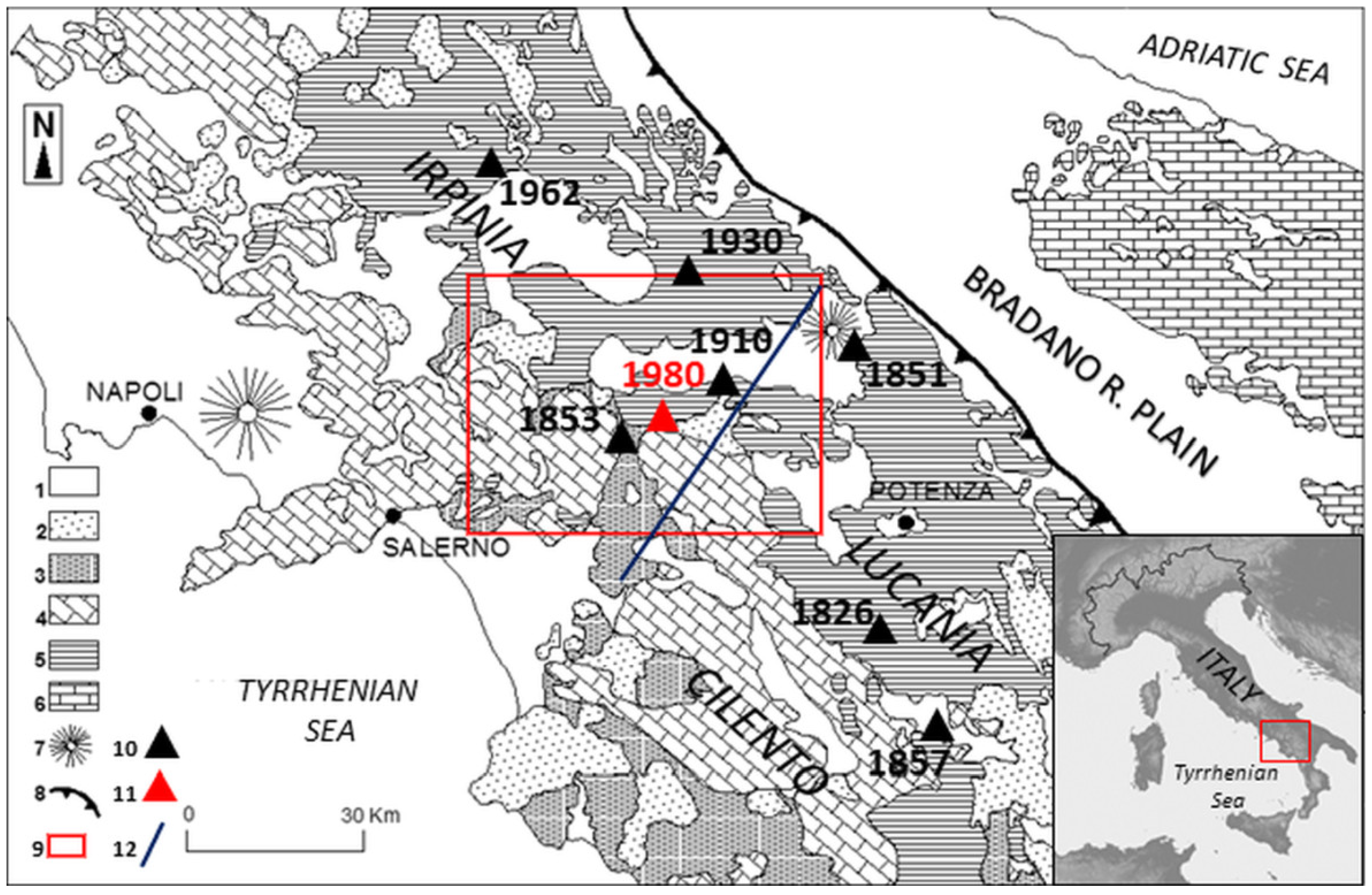
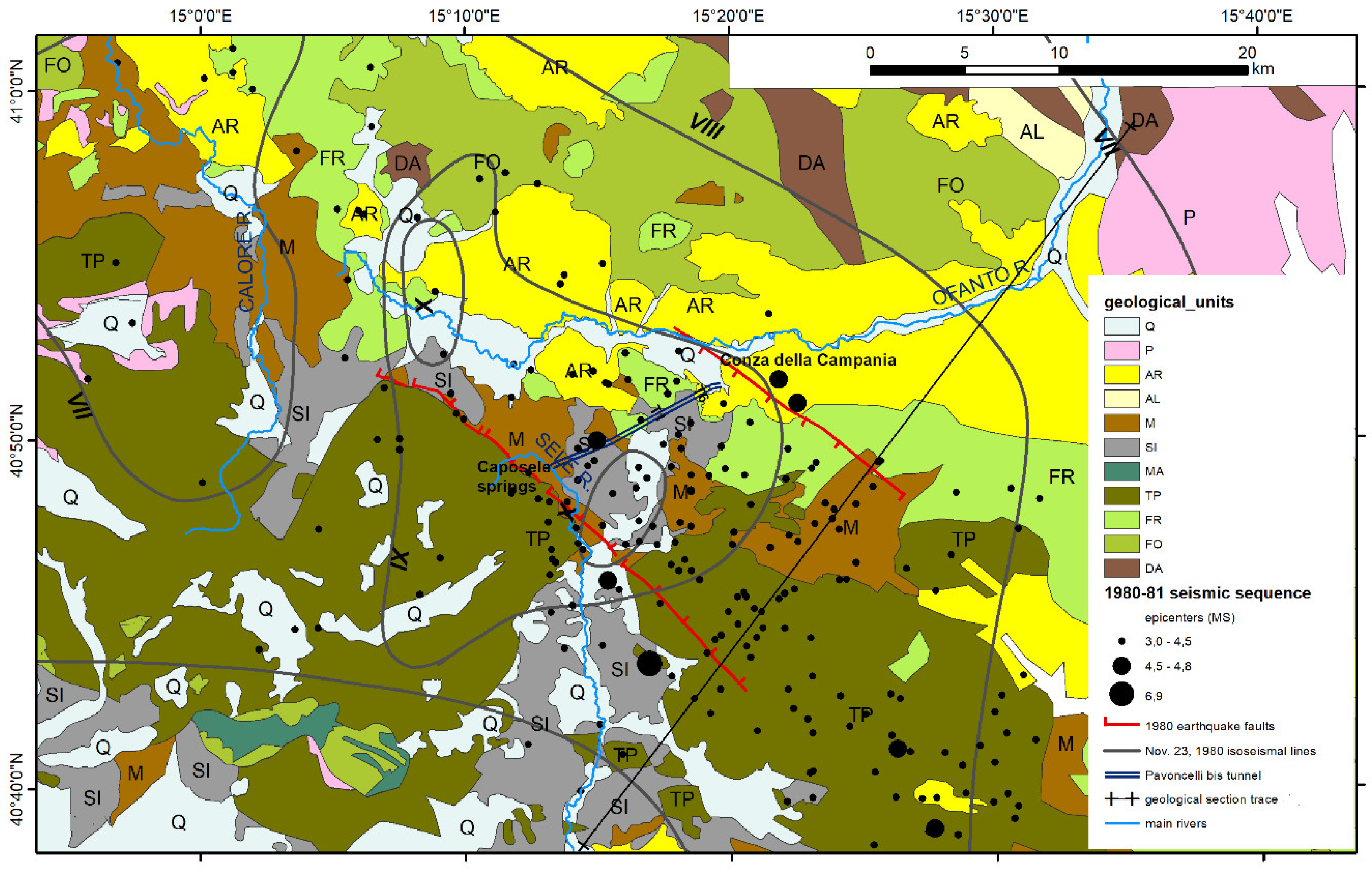
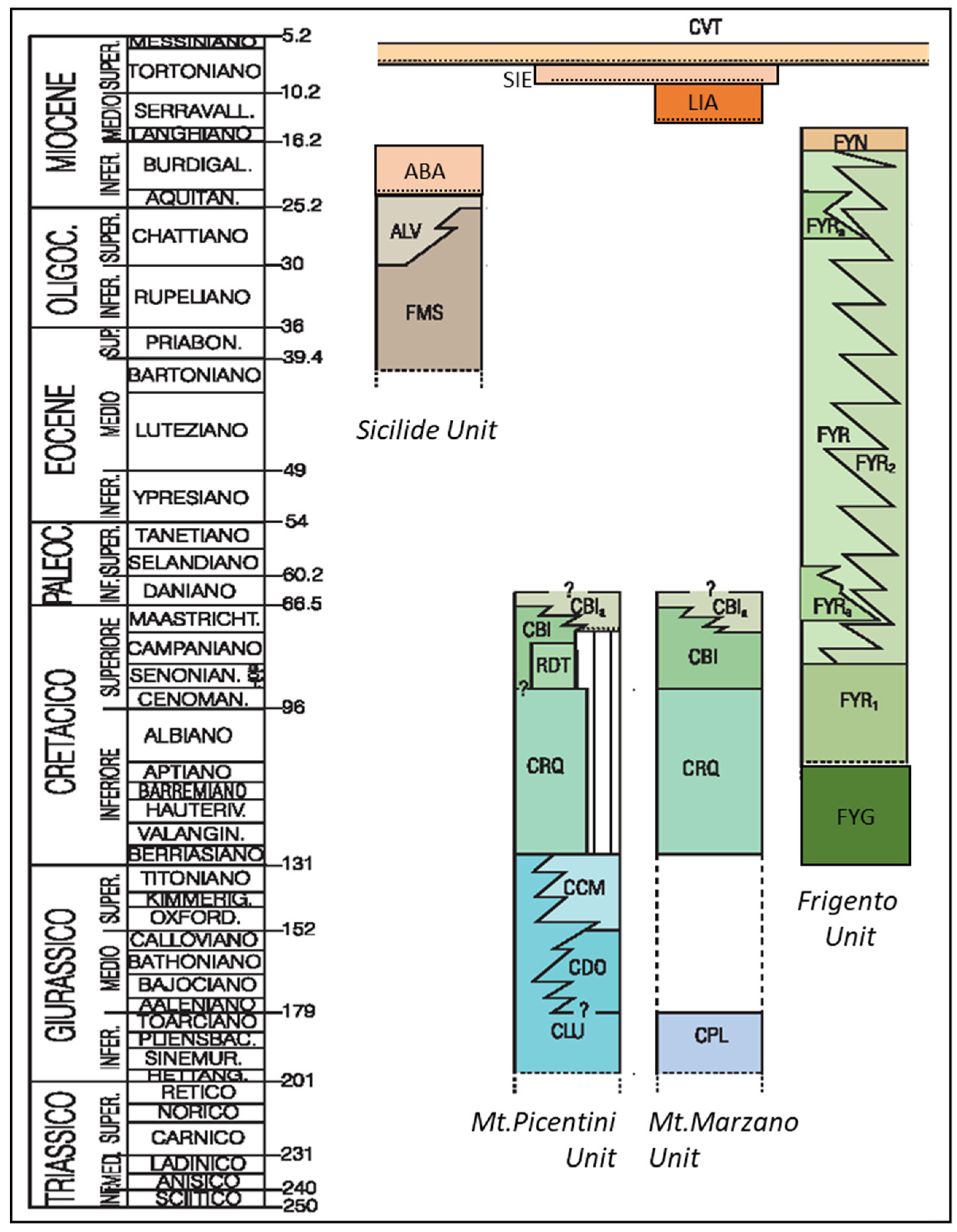
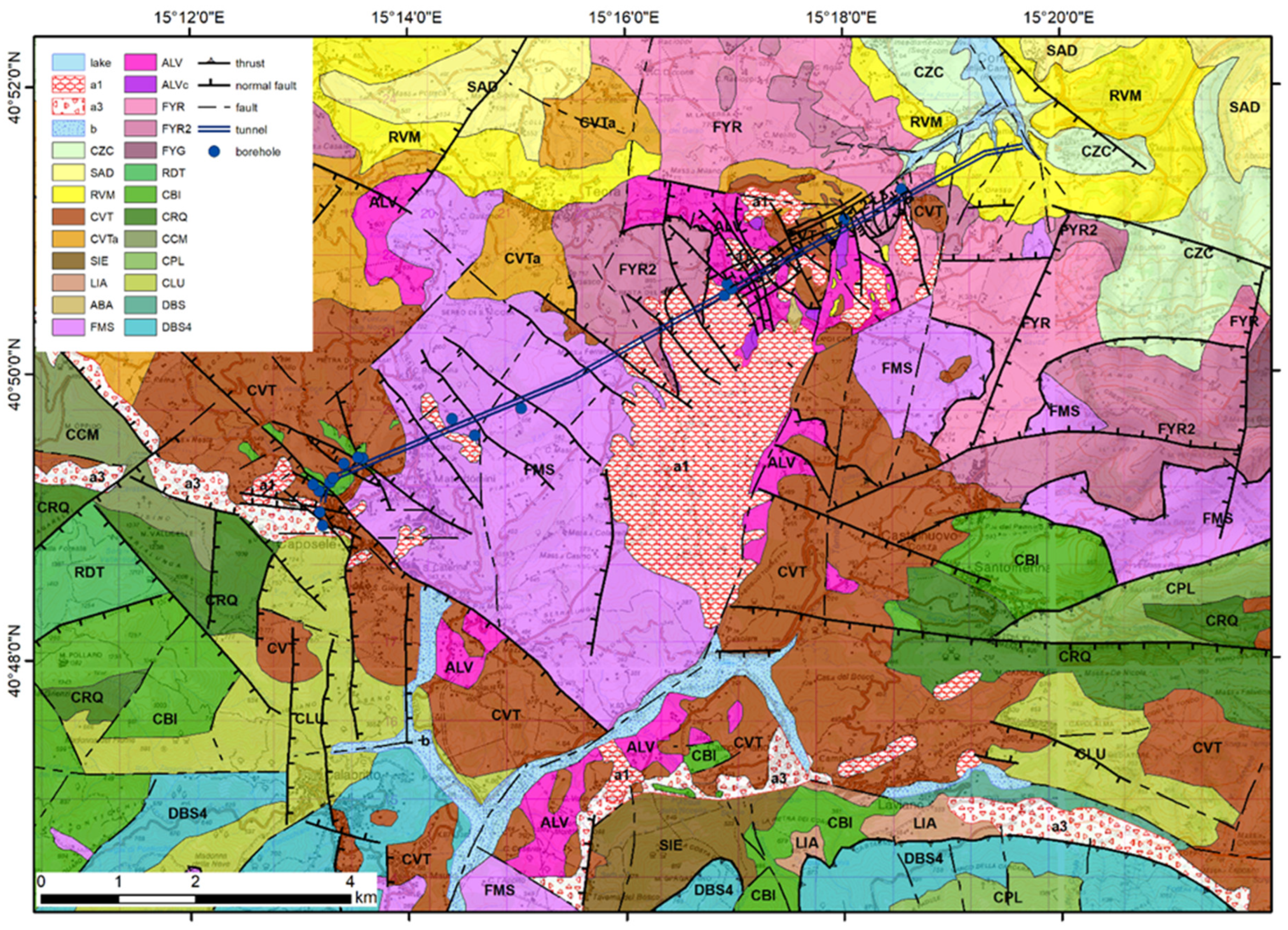
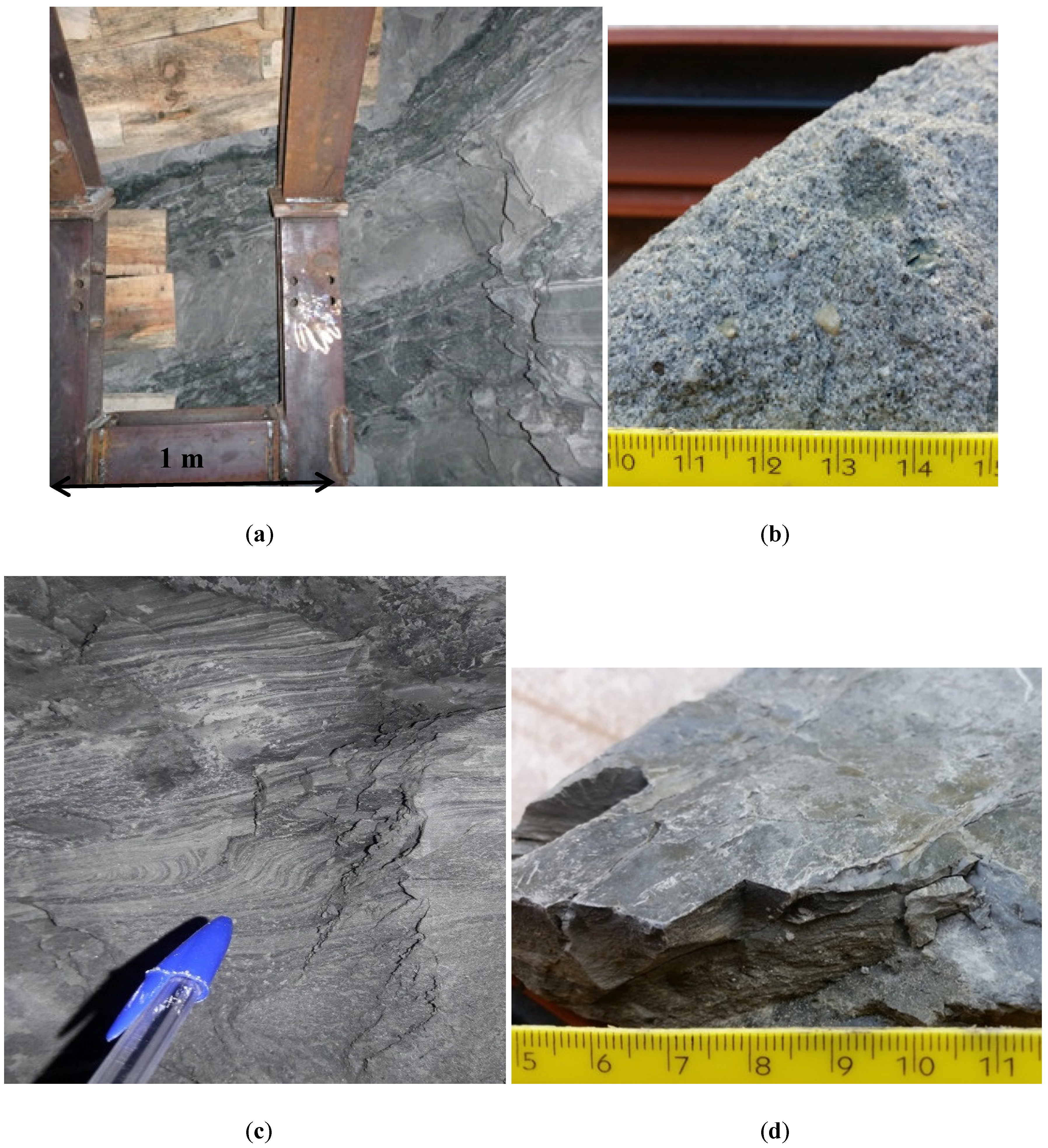
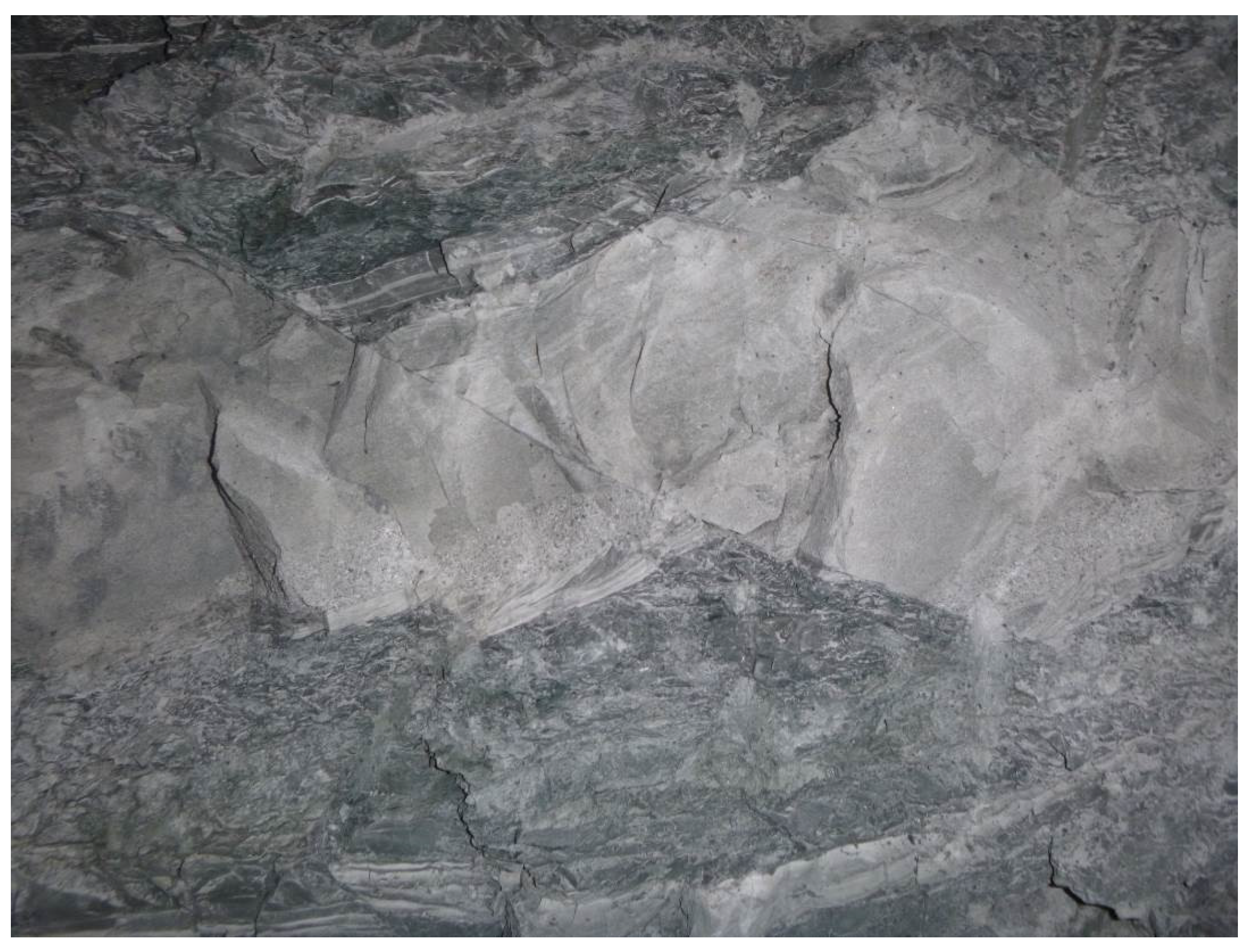
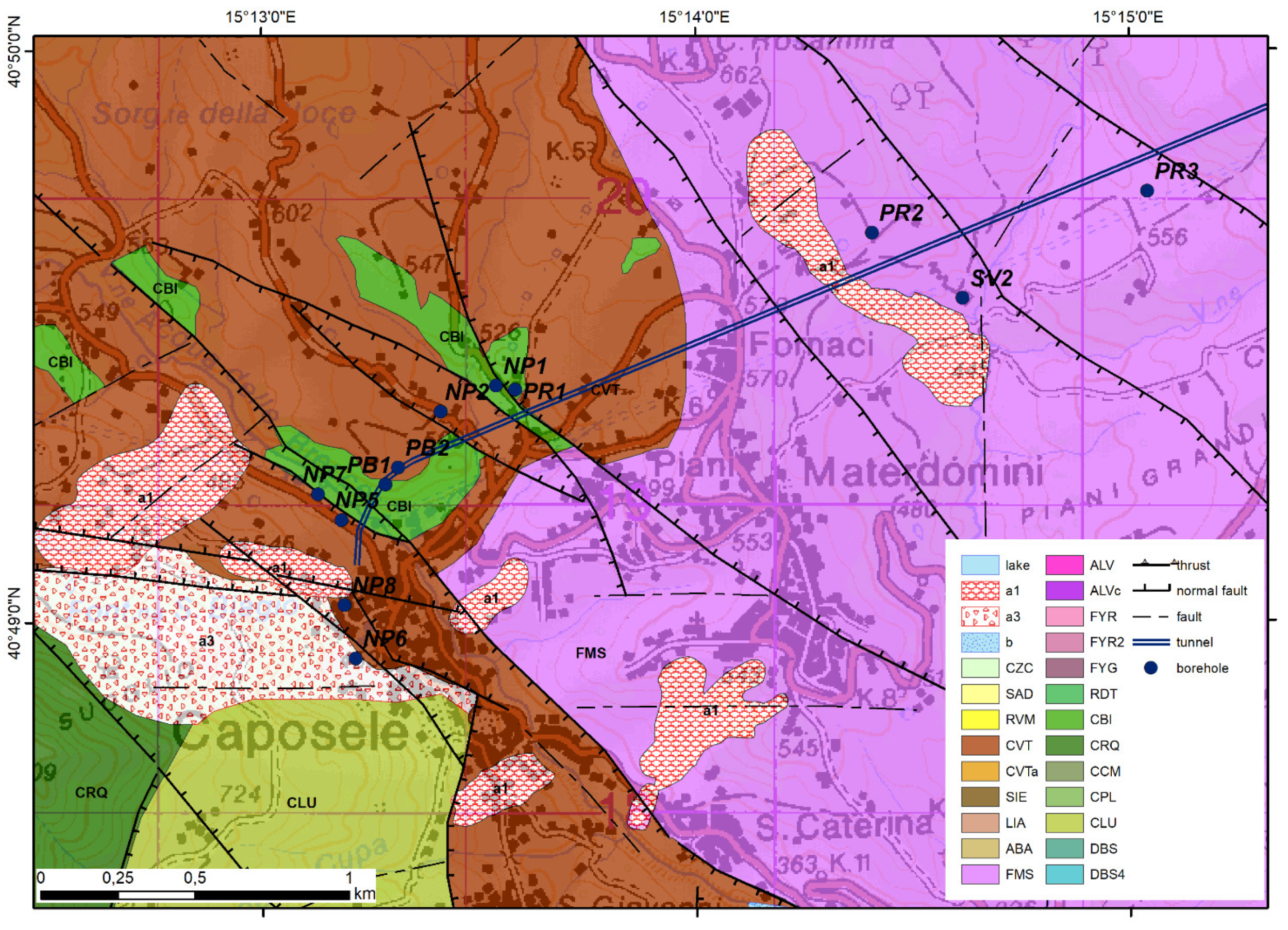
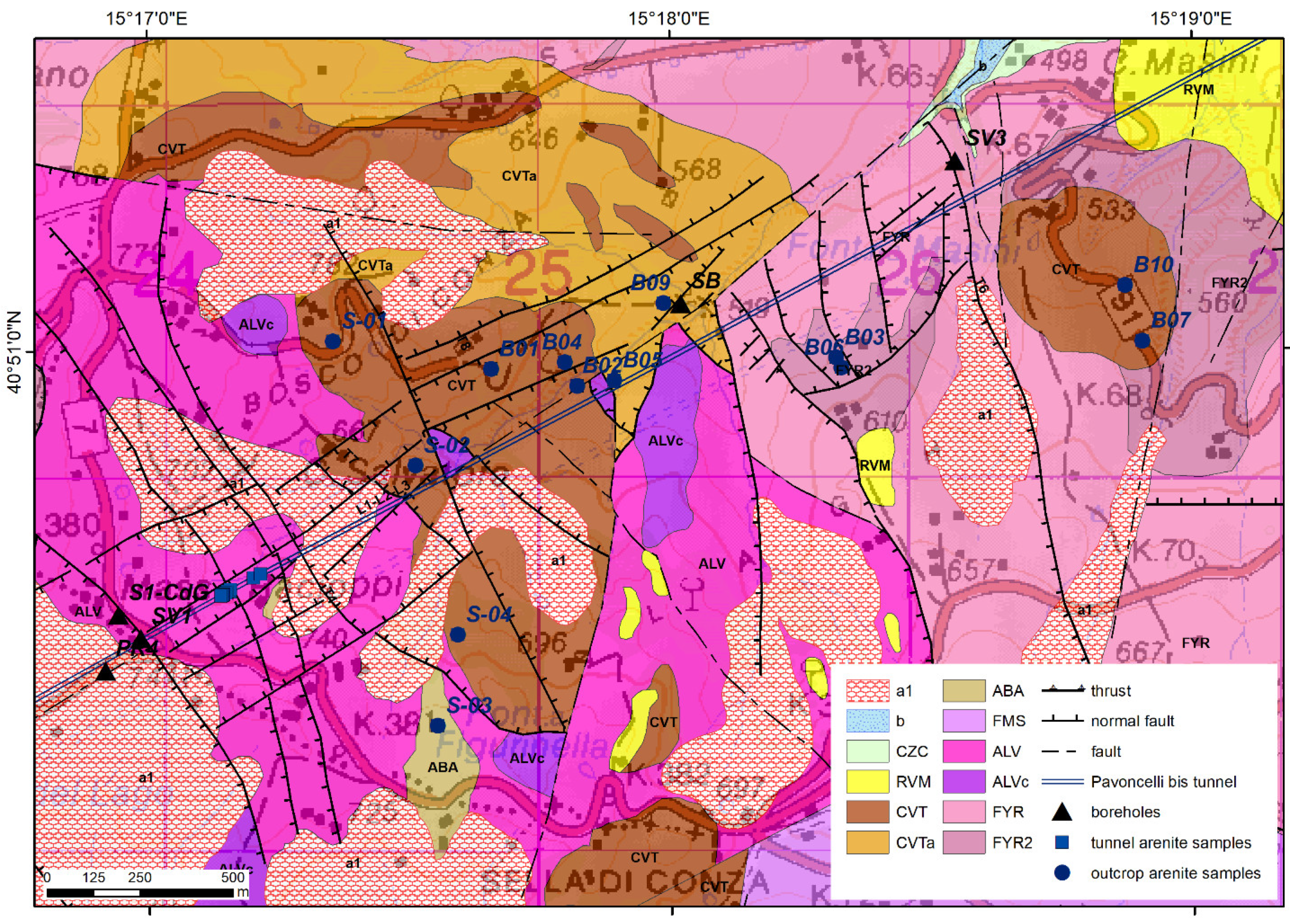
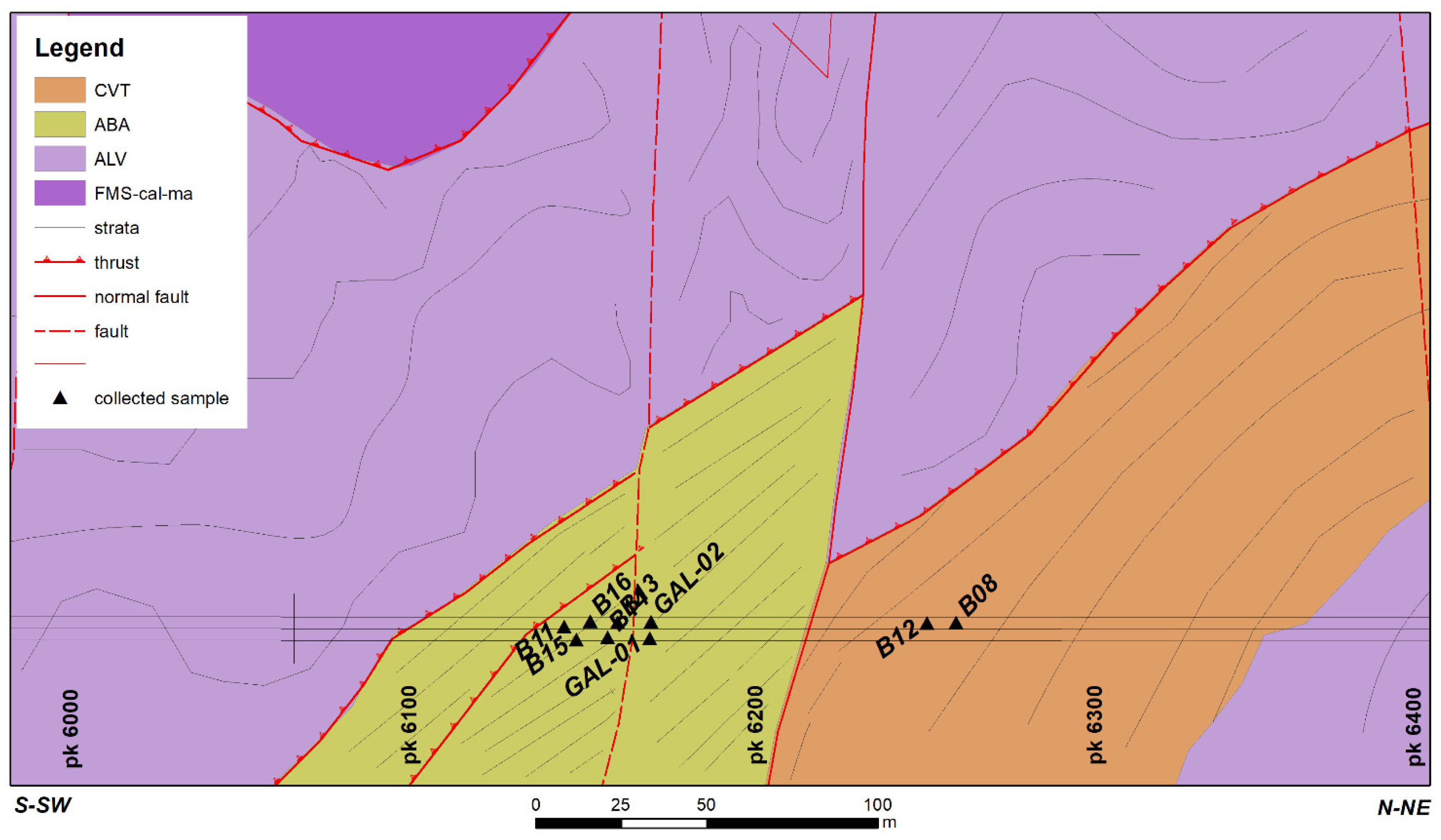
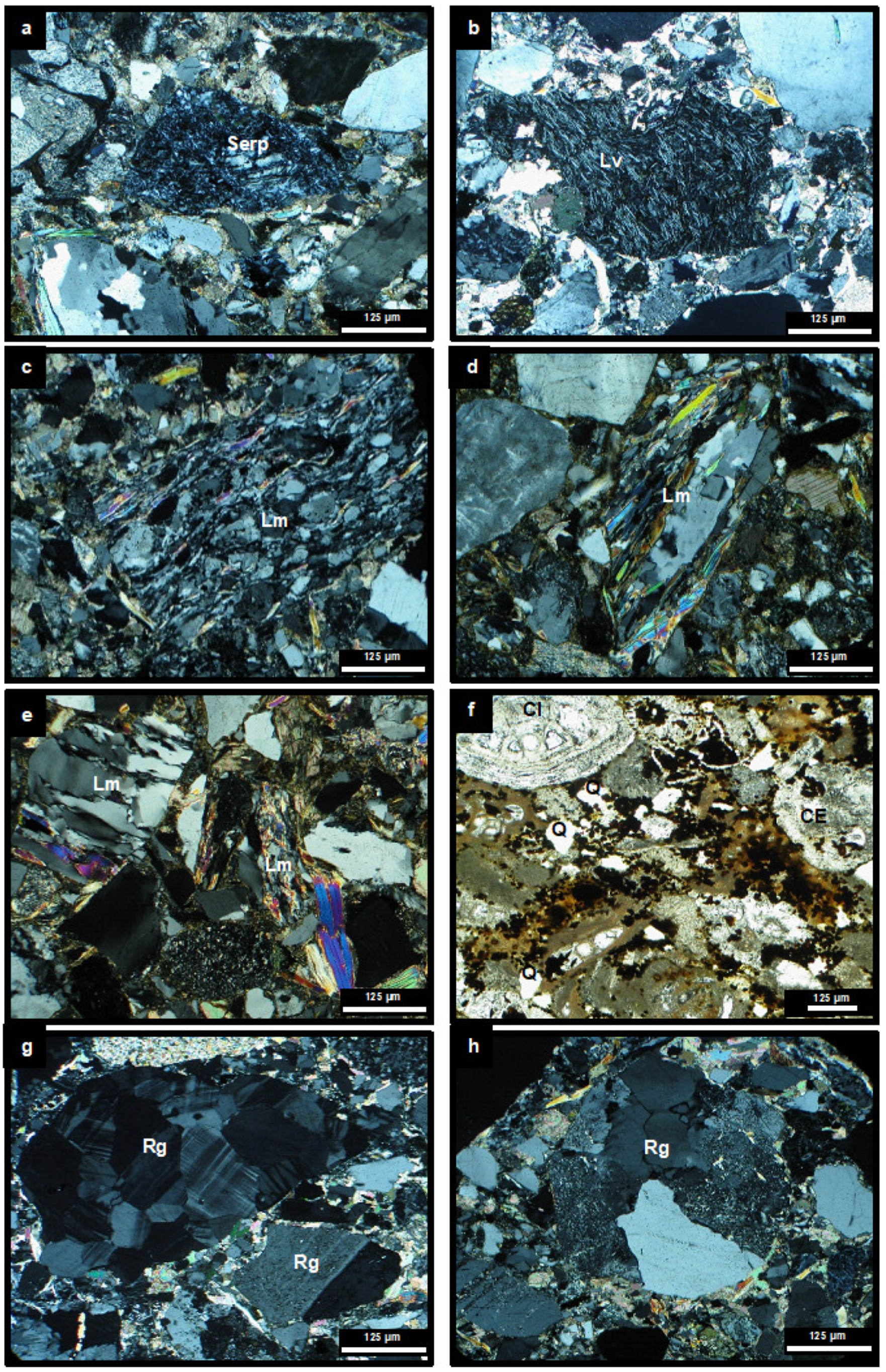
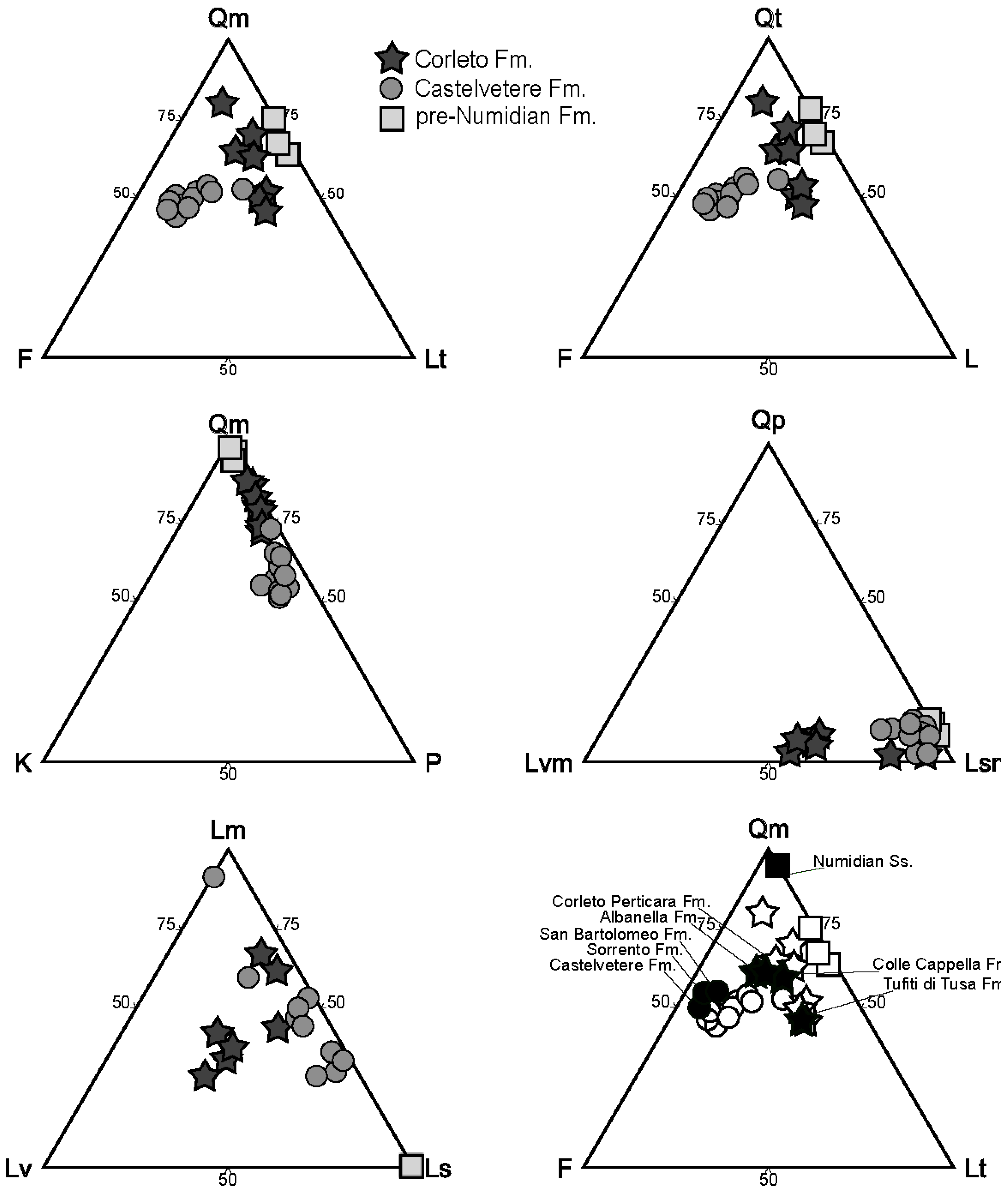
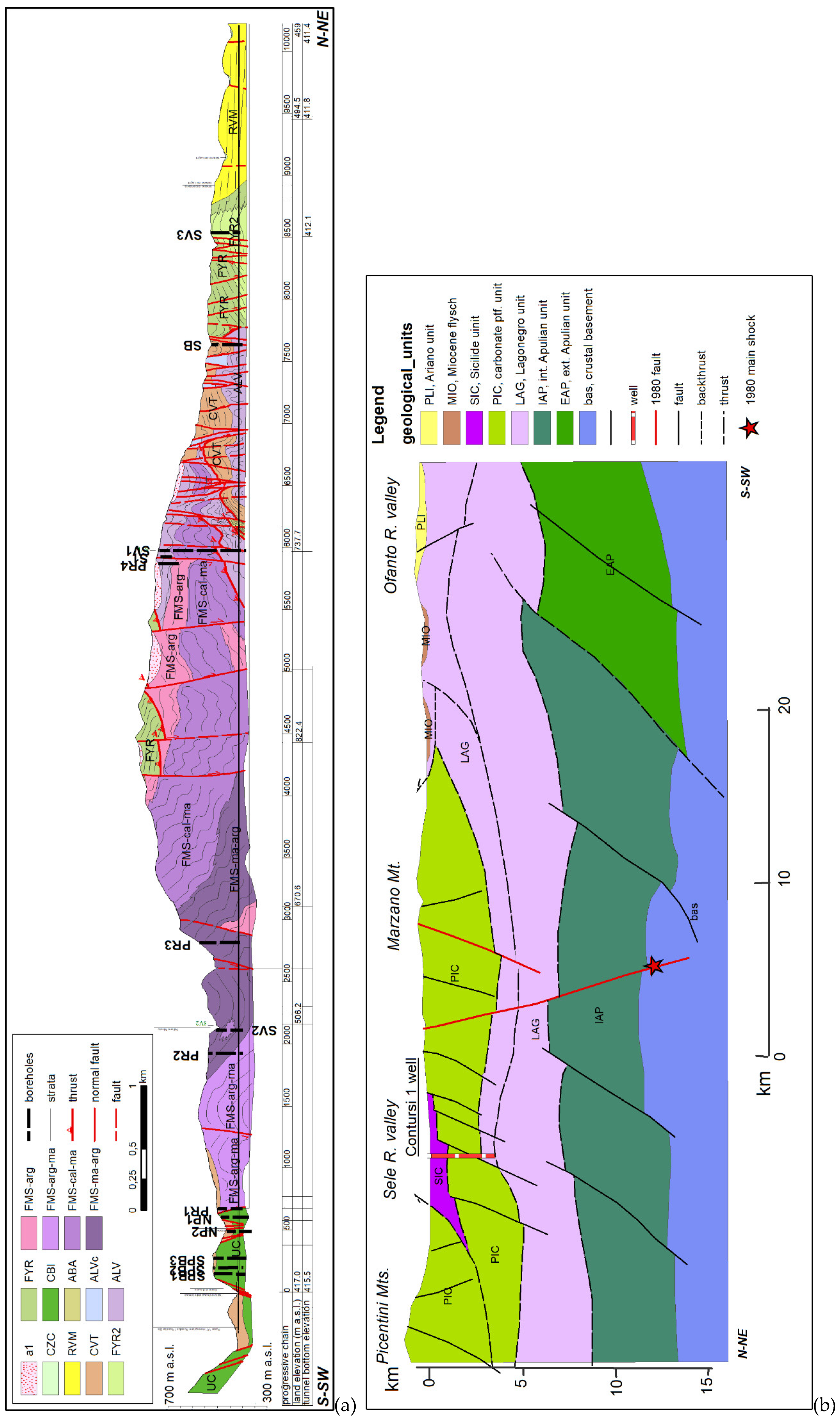
| Chainage Interval | Description of Lithological Intervals | Geological Unit Interpretation |
|---|---|---|
| 0–655 m | limestones | CBI |
| 655–2000 m | clays, shale, and marls | FMS-arg-ma |
| 2000–4300 m | marls and clays | FMS-ma-arg |
| 4300–5000 m | marly-calcareous turbidites | FMS- cal-ma |
| 5000–5300 m | clay, dark clays, and clayey silts | FMS-arg |
| 5300–5600 m | calcareous-clay turbidites | FMS-cal-ma |
| 5600–6100 m | clayey turbidites, calcareous fault breccia, dark clayey marls, and argillites | ALV |
| 6100–6233 m | well stratified arenites and marly clays, interbedded with thin layers of sandy silt and dark grey argillite, quartzarenites, and dark siltites and argillites | ABA |
| 6233–6357 m | coarse to fine grained quartzofeldspathic sandstones | CVT |
| 6357–7760 m | dark argillites and marls with layers of reddish clays and whitish marly limestone, calcilutites and calcarenites; within 6448 m–6463 m and 6709–6725 m intervals, some thick CVT arenite strata are present | ALV |
| 7760–8500 m | grey argillites and marls with reddish clayey marls, marly limestones, and bioclastic calcirudites | FYR |
| Borehole | Chainage (Approx.) | Description of Lithological Intervals | Geological Units (Thickness) |
|---|---|---|---|
| NP6 | near Caposele | 0–12 m, arenite; 12–21 m, arenite and limestone; 21–40 m, limestone | CVT (0–21 m); CBI (21–40 m) |
| NP8 | near Caposele | 0–23 m, arenite and clay; 23–27 m, limestone; 27–42 m, arenite and limestone; 42–50 m, limestone | CVT (0–23 m); CBI (23–50 m) |
| NP5 | 10 | 0–50 m, clays with limestone; 50–58 m, limestone | CVT (0–50 m); CBI (50–58 m) |
| NP7 | 20 | 0–32 m, clay and limestone; 32–60 m, limestone | CVT (0–32 m); CBI (32–60 m) |
| PB1 | 150 | 0–3 m, silt; 3–120 m, limestone | CBI (0–120 m) |
| PB2 | 200 | 0–11 m, silt; 11–120 m, limestone | CVT (0–11m), CBI (11–120 m) |
| NP2 | 490 | 0–4 m, clay; 4–35 m, sand; 35–43 m, clays with limestone; 43–110 m, limestone | CVT (0–43 m); CBI (43–110 m) |
| NP1 | 600 | 0–120 m, limestone | CBI (0–120 m) |
| PR1 | 655 | 0–20 m, no data; 20–80 m, marl, clayey marl, clay; 80–95 m, limestone | CVT (0–20 m), FMS arg-ma (20–80 m), CBI (80–95 m) |
| PR2 | 1920 | 0–95 m, no data; 95–135 m, marl, clayey marl, clay | FMS ma-arg, FMS arg-ma (0–135 m) |
| SV2 | 2150 | 0–39 m, clay and marl; 39–100 m, clayey marl, calcareous marl, marly limestone | FMS ma-arg; FMS cal-ma (0–100 m) |
| PR3 | 2810 | 0–120 m, no data; 120–160 m, marl, clayey marl, clay | FMS ma-arg (0–120 m) |
| PR4 | 5850 | 0–20 m, no data; 20–85 m, marl, clayey marl, clay | ALV; FMS arg (0–85 m) |
| S1-CdG | 5920 | 0–65 m, marl, clayey marl, clay | ALV (0–65 m) |
| SV1 | 5960 | 0–11 m, silty clay; 11–197 m marl, clayey marl, calcareous marl, limestone, silty marl; 197–199 m clay; 199–350 m, marl, clayey marl, calcareous marl, marly limestone, silty marl | ALV (0–11 m); FMS cal-ma (11–197 m); ALV (197–350 m) |
| SB | 7630 | 0–50 m, no data; 50–107 m clay and quartz-feldspatic arenite; 107–130 m, arenite, calcarenite, reddish clay | CVT (0–130 m) |
| SV3 | 8540 | 0–100 m, reddish clay and limestone | FYR (0–100 m) |
| Unit | Corleto Perticara Fm. | pre-Numidian seq. | Castelvetere Fm. | ||||||||||||||||||
|---|---|---|---|---|---|---|---|---|---|---|---|---|---|---|---|---|---|---|---|---|---|
| sample | GAL01 | GAL02 | S03 | B11 | B13 | B14 | B15 | B03 | B06 | B09 | S01 | S02 | S04 | B01 | B02 | B04 | B05 | B07 | B08 | B10 | B12 |
| Petrographic classes | |||||||||||||||||||||
| Quartz (Qt = Qm + Qp) | |||||||||||||||||||||
| Quartz (single crystals) | 195 | 114 | 167 | 165 | 116 | 154 | 152 | 45 | 38 | 27 | 173 | 190 | 164 | 153 | 129 | 126 | 137 | 144 | 127 | 149 | 151 |
| Polycrystalline quartz with tectonic fabric | 1 | 1 | 2 | 6 | 1 | 3 | 2 | 2 | 1 | 1 | 5 | 5 | 1 | 1 | 1 | 3 | 3 | 1 | 2 | 1 | |
| Polycrystalline quartz without tectonic fabric | 1 | 1 | 2 | 2 | |||||||||||||||||
| Quartz in metamorphic r.f. | 17 | 2 | 3 | 16 | 34 | 8 | 3 | 18 | 4 | 2 | 4 | 3 | 6 | 16 | 2 | 1 | 3 | ||||
| Quartz in plutonic r.f. | 1 | 4 | 27 | 3 | 22 | 6 | 5 | 18 | 1 | 1 | 13 | 1 | 6 | ||||||||
| Quartz in plutonic or gneissic r.f. | 3 | 4 | |||||||||||||||||||
| Calcite replacement on quartz | 6 | ||||||||||||||||||||
| Feldspars (F = K + P) | |||||||||||||||||||||
| K-feldspar (single crystals) | 5 | 3 | 1 | 5 | 1 | 2 | 20 | 38 | 23 | 10 | 8 | 14 | 2 | 8 | 16 | 7 | 23 | ||||
| K-feldspar in plutonic r.f. | 5 | 3 | 5 | 16 | 13 | 19 | 6 | 5 | 4 | 2 | 10 | 5 | 9 | ||||||||
| Calcite replacement in k-feldspar | 1 | 1 | |||||||||||||||||||
| Plagioclase (single crystals) | 51 | 18 | 37 | 29 | 29 | 25 | 19 | 1 | 1 | 89 | 83 | 89 | 68 | 63 | 66 | 36 | 57 | 69 | 57 | 85 | |
| Plagioclase in metamorphic r.f. | 8 | 7 | 8 | 2 | 5 | 4 | 5 | 2 | 1 | 6 | 2 | 1 | 1 | ||||||||
| Plagioclase in plutonic r.f. | 9 | 12 | 3 | 38 | 21 | 44 | 21 | 19 | 39 | 11 | 15 | 25 | 12 | 33 | |||||||
| Plagioclase in plutonic or gneissic r.f. | 2 | 6 | |||||||||||||||||||
| Plagioclasio in volcanic r.f. | 1 | ||||||||||||||||||||
| Calcite replacement in Plagioclase | 5 | 1 | |||||||||||||||||||
| Micas | |||||||||||||||||||||
| Micas and clorite (single crystals) | 58 | 40 | 73 | 18 | 15 | 30 | 25 | 1 | 2 | 1 | 2 | 7 | 3 | 4 | 3 | 2 | 31 | 2 | 6 | 1 | 3 |
| Micas in plutonic r.f. | 1 | 1 | 1 | ||||||||||||||||||
| Micas in metamorphic r.f. | 2 | 5 | 3 | 1 | |||||||||||||||||
| Lithic fragments (L = Lm + Lv + Ls) | |||||||||||||||||||||
| Volcanic lithic with microlithic fabric | 37 | 1 | 19 | 25 | 8 | 7 | 4 | 1 | 2 | ||||||||||||
| Volcanic lithic with felsitic granular texture | 2 | 9 | 9 | 6 | 4 | 4 | 2 | 1 | 2 | 5 | 3 | 5 | 1 | 1 | 1 | ||||||
| Volcanic lithic with felsitic seriate texture | 3 | 5 | 8 | 3 | 1 | ||||||||||||||||
| Volcanic lithic with lathwork texture | 1 | ||||||||||||||||||||
| Volcanic lithic with vitric texture | 1 | 1 | 1 | ||||||||||||||||||
| Serpentinite | 13 | 3 | 3 | 8 | 4 | 2 | 1 | ||||||||||||||
| Serpentine-schist | 4 | 1 | 4 | 2 | 1 | 2 | 1 | 1 | |||||||||||||
| Phyllite | 53 | 7 | 31 | 27 | 27 | 19 | 15 | 19 | 12 | 15 | 16 | 11 | 23 | 36 | 15 | 10 | 14 | 8 | |||
| Fine-grained Schist | 4 | 16 | 6 | 1 | 13 | 3 | 11 | 1 | 1 | 6 | 2 | 1 | 1 | 5 | |||||||
| Fine-grained Gneiss | 7 | ||||||||||||||||||||
| Siltstone | 2 | 2 | 2 | 3 | 1 | 2 | 2 | 1 | |||||||||||||
| Impure Chert | 3 | 4 | 3 | 3 | 1 | 2 | 2 | 3 | 3 | 1 | 3 | 1 | |||||||||
| Shale | 1 | 3 | 3 | 2 | 1 | 3 | 1 | ||||||||||||||
| Dense minerals | |||||||||||||||||||||
| Dense mineral (single crystal) | 10 | 5 | 2 | 10 | 8 | 13 | 12 | 2 | 1 | 3 | 1 | 2 | 2 | 1 | 2 | 4 | 3 | 2 | 2 | 1 | |
| Dense mineral in plutonic r.f. | 1 | ||||||||||||||||||||
| Dense mineral in metamorphic r.f. | 4 | 3 | 1 | ||||||||||||||||||
| Opaque minerals | 4 | 1 | 3 | 3 | 1 | 1 | 1 | 2 | 1 | 1 | |||||||||||
| Extrabasinal Carbonates (EC) | |||||||||||||||||||||
| Dolostone | 6 | 2 | 1 | 1 | |||||||||||||||||
| Micritic Limestone | 7 | 3 | 11 | 9 | 6 | 8 | 7 | 3 | 4 | 4 | 4 | 4 | 7 | 6 | 7 | 4 | 10 | 4 | 4 | 1 | |
| Sparitic Limestone | 1 | 5 | 3 | 2 | 4 | 3 | 4 | 2 | 2 | 2 | 8 | 3 | 3 | 2 | |||||||
| Microsparitic Limestone | 6 | 4 | 4 | 1 | 2 | 3 | 1 | 4 | 1 | 1 | |||||||||||
| Biomicritic Limestone | 4 | 4 | 4 | 7 | 2 | 2 | 1 | 1 | 1 | 8 | 3 | 7 | 6 | 8 | 2 | 11 | 3 | 10 | 6 | ||
| Biosparitic Limestone | 3 | 2 | 3 | 1 | 1 | 1 | 1 | ||||||||||||||
| Fossil (single skeleton) | 1 | 1 | 1 | 6 | 9 | 4 | 1 | 1 | 1 | 1 | 1 | ||||||||||
| Fossil in Limestone-Dolostone | 2 | 1 | 3 | 4 | 2 | ||||||||||||||||
| Single spar (calcite) | 1 | 1 | 4 | 5 | 4 | 2 | 1 | ||||||||||||||
| Single spar (dolomite) | 2 | 1 | |||||||||||||||||||
| Intrabasinal Carbonates (IC) and noncarbonates (INC) | |||||||||||||||||||||
| Bioclast | 3 | 1 | 187 | 180 | 190 | 4 | 5 | ||||||||||||||
| Peloids | 2 | 4 | 3 | ||||||||||||||||||
| Glauconite | 2 | 3 | 1 | 1 | 3 | 2 | 3 | 1 | 1 | 1 | |||||||||||
| Rip-Up clasts | 2 | 2 | 3 | 18 | 16 | 9 | 2 | 5 | 3 | 7 | 5 | ||||||||||
| Interstitial components (matrix and cements) | |||||||||||||||||||||
| Siliciclastic matrix | 24 | 21 | 13 | 12 | 8 | 8 | 16 | 6 | 4 | 8 | 27 | 17 | 6 | 31 | 15 | 12 | 23 | 13 | |||
| Carbonate matrix (micrite) | 54 | 50 | 47 | 2 | 2 | 3 | 2 | 3 | |||||||||||||
| Carbonate cement (pore-filling) | 1 | 7 | 14 | 2 | 4 | 5 | 2 | 65 | 55 | 57 | 20 | 9 | 19 | 56 | 66 | 6 | 63 | 13 | 52 | 8 | |
| Carbonate cement (patchy calcite) | 18 | 48 | 91 | 11 | 26 | 38 | 32 | 14 | 22 | 12 | 1 | 52 | 28 | 38 | 16 | 11 | 16 | 7 | 14 | 21 | 21 |
| Calcite replacement on underterm. grain | 2 | 9 | 15 | 5 | 17 | 15 | 5 | 11 | 21 | 24 | 5 | 21 | 7 | 17 | |||||||
| Siliceous cement | 1 | 2 | 1 | ||||||||||||||||||
| Phyllosilicate cement | 2 | 2 | 1 | 4 | 3 | 5 | 1 | 1 | 4 | ||||||||||||
| Oxid-Fe cement | 2 | 12 | 8 | 8 | 1 | ||||||||||||||||
| Alterites (indeterminate alterite grain) | 1 | 1 | 1 | 1 | 2 | ||||||||||||||||
| total counted points | 546 | 272 | 472 | 419 | 420 | 374 | 322 | 400 | 383 | 364 | 448 | 527 | 500 | 438 | 408 | 444 | 393 | 400 | 349 | 412 | 400 |
| Corleto Perticara Fm. | pre-Numidian | Castelvetere Fm. | ||||||||||||||||||
|---|---|---|---|---|---|---|---|---|---|---|---|---|---|---|---|---|---|---|---|---|
| Sample | GAL-01 | GAL-02 | S-03 | B-11 | B-13 | B-14 | B-15 | B-03 | B-06 | B-09 | S-02 | S-04 | B-01 | B-02 | B-04 | B-05 | B-07 | B-08 | B-10 | B-12 |
| Qm | 50 | 80 | 65 | 52 | 46 | 63 | 70 | 75 | 64 | 68 | 48 | 44 | 52 | 50 | 47 | 53 | 52 | 49 | 54 | 46 |
| F | 17 | 12 | 16 | 14 | 17 | 12 | 9 | 0 | 2 | 3 | 39 | 43 | 33 | 35 | 38 | 20 | 29 | 42 | 29 | 44 |
| Lt | 33 | 8 | 19 | 34 | 37 | 25 | 21 | 25 | 34 | 29 | 13 | 13 | 15 | 15 | 15 | 27 | 19 | 9 | 17 | 10 |
| Qt | 51 | 80 | 65 | 54 | 48 | 65 | 72 | 78 | 68 | 70 | 49 | 46 | 53 | 51 | 47 | 56 | 54 | 50 | 56 | 48 |
| F | 17 | 12 | 16 | 14 | 17 | 12 | 9 | 0 | 2 | 3 | 39 | 43 | 33 | 35 | 38 | 20 | 29 | 42 | 29 | 44 |
| L | 32 | 8 | 19 | 32 | 35 | 23 | 19 | 22 | 32 | 27 | 12 | 11 | 14 | 14 | 15 | 24 | 17 | 8 | 15 | 8 |
| Qm | 74 | 87 | 80 | 79 | 72 | 83 | 88 | 100 | 97 | 96 | 55 | 51 | 61 | 58 | 54 | 73 | 64 | 53 | 65 | 52 |
| K | 4 | 0 | 2 | 2 | 5 | 1 | 1 | 0 | 0 | 0 | 14 | 11 | 6 | 6 | 7 | 2 | 4 | 10 | 5 | 10 |
| P | 22 | 13 | 18 | 19 | 23 | 16 | 11 | 0 | 3 | 4 | 31 | 38 | 33 | 36 | 39 | 25 | 32 | 37 | 30 | 38 |
| Qp | 3 | 0 | 2 | 5 | 7 | 6 | 9 | 13 | 11 | 8 | 13 | 11 | 9 | 10 | 2 | 10 | 8 | 8 | 11 | 12 |
| Lvm | 43 | 17 | 6 | 35 | 41 | 35 | 32 | 0 | 0 | 0 | 5 | 2 | 4 | 12 | 6 | 15 | 2 | 8 | 6 | 6 |
| Lsm | 54 | 83 | 92 | 60 | 52 | 59 | 59 | 87 | 89 | 92 | 82 | 87 | 87 | 78 | 92 | 75 | 90 | 84 | 83 | 82 |
| Lm | 44 | 67 | 62 | 42 | 29 | 34 | 38 | 0 | 0 | 0 | 30 | 53 | 36 | 29 | 50 | 59 | 35 | 46 | 36 | 43 |
| Lv | 41 | 8 | 6 | 32 | 42 | 34 | 30 | 0 | 0 | 0 | 6 | 2 | 4 | 12 | 6 | 15 | 2 | 8 | 4 | 7 |
| Ls | 15 | 25 | 32 | 26 | 29 | 32 | 32 | 100 | 100 | 100 | 64 | 45 | 60 | 59 | 44 | 26 | 63 | 46 | 60 | 50 |
| Description and Location of Unit | N | QtFL | QmFLt | QmKP | QpLvmLsm | LmLvLs | RgRsRm |
|---|---|---|---|---|---|---|---|
| Quartzolithic suite | |||||||
| Corleto-Perticara Formation | 55 | 66 (± 4)–18 (± 6)–16 (± 7) | 62 (± 4)–18 (± 6)–20 (± 7) | 71 (± 5)–8 (± 3)–16 (± 4) | 8 (± 3)–16 (± 5)–76 (± 7) | 64 (± 11)–16 (± 3)–20 (± 6) | − |
| Albanella Fm. | 15 | 66 (± 4)–16 (± 6)–18 (± 7) | 62 (± 4)–16 (± 6)–22 (± 7) | 74 (± 6)–5 (± 3)–21 (± 5) | 3 (± 3)–10 (± 6)–87 (± 6) | 84 (± 6)–6 (± 5)–10 (± 5) | 6 (± 3)–6 (± 6)–88 (± 11) |
| Colle Cappella Formation | 24 | 64 (± 4)–16 (± 6)–20 (± 7) | 60 (± 4)–16 (± 6)–24 (± 7) | 73 (± 3)–6 (± 2)–16 (± 2) | 11 (± 6)–2 (± 3)–87 (± 7) | 72 (± 14)–4 (± 3)–24 (± 6) | 6 (± 3)–15 (± 6)–79 (± 11) |
| Tufiti di Tusa Formation (quartzolithic suite) | 16 | 50 (± 18)–18 (± 3)–32 (± 16) | 46 (± 18)–18 (± 3)–36 (± 16) | 70 (± 5)–3 (± 2)–27 (± 5) | 8 (± 3)–26 (± 5)–66 (± 8) | 47 (± 7)–29 (± 7)–24 (± 3) | − |
| Tufiti di Tusa Formation (volcanolithic suite) | 22 | 14 (± 6)–28 (± 15) 58 (± 13) | 12 (± 6)–28 (± 15)–60 (± 13) | 28 (± 6)–2 (± 15)–70 (± 13) | 4 (± 3)–90 (± 6)–6 (± 4) | 8 (± 3)–88 (± 7)–4 (± 3) | − |
| Corleto Formation in wells | 7 | 62 (± 11)–14 (± 3)–24 (± 9) | 61 (± 11)–14 (± 3)–25 (± 9) | 80 (± 6)–2 (± 2)–18 (± 4) | 4 (± 3)–30 (± 12)–66 (± 14) | 45 (± 13)–28 (± 14)–27 (± 6) | 6 (± 3)–15 (± 6)–79 (± 11) |
| Quartzofeldspathic suite | |||||||
| Castelvetere Formation | 68 | 46 (± 4)–42 (± 6)–12 (± 5) | 45 (± 4)–42 (± 6)–13 (± 5) | 52 (± 6)–15 (± 5)–33 (± 4) | 9 (± 4)–6 (± 7)–85 (± 9) | 41 (± 14)–5 (± 5)–54 (± 16) | 54 (± 16)–20 (± 9)–26 (± 12) |
| Castelvetere Formation in wells | 11 | 50 (± 4)–42 (± 6)–8 (± 5) | 48 (± 4)–42 (± 6)–10 (± 5) | 52 (± 6)–15 (± 5)–33 (± 4) | 9 (± 4)–6 (± 7)–85 (± 9) | 41 (± 14)–5 (± 5)–54 (± 16) | 54 (± 16)–20 (± 9)–26 (± 12) |
| Sorrento Sandstone Formation | 30 | 55 (± 5)–40 (± 6)–5 (± 2) | 53 (± 5)–40 (± 6)–7 (± 2) | 56 (± 5)–22 (± 4)–22 (± 4) | 22 (± 12)–4 (± 2)–74 (± 12) | 41 (± 14)–5 (± 5)–54 (± 16) | 54 (± 7)–13 (± 8)–33 (± 8) |
| San Bartolomeo Formation | 46 | 55 (± 7)–34 (± 7)–11 (± 7) | 52 (± 7)–34 (± 7)–14 (± 7) | 60 (± 7)–17 (± 3)–23 (± 5) | 25 (± 12)–0 (± 0)–75 (± 12) | 45 (± 18)–0 (± 0)–55 (± 18) | 12 (± 8)–39 (± 16)–49 (± 17) |
| Quartzarenite suite | |||||||
| pre-Numidian Hybrid arenites | 3 | 72 (± 3)–2 (± 2)–26 (± 3) | 69 (± 3)–2 (± 2)–29 (± 3) | 98 (± 4)–0 (± 0)–2 (± 1) | − | − | − |
| Numidian Sandstone (southern Apennines) | 39 | 95 (± 5)–5 (± 5)–0 (± 0) | 95 (±5)–5 (±5)–0 (±0) | 97 (± 5)–0 (± 0)–3 (± 1) | − | − | − |
© 2020 by the authors. Licensee MDPI, Basel, Switzerland. This article is an open access article distributed under the terms and conditions of the Creative Commons Attribution (CC BY) license (http://creativecommons.org/licenses/by/4.0/).
Share and Cite
Matano, F.; Di Nocera, S.; Criniti, S.; Critelli, S. Geology of the Epicentral Area of the November 23, 1980 Earthquake (Irpinia, Italy): New Stratigraphical, Structural and Petrological Constrains. Geosciences 2020, 10, 247. https://doi.org/10.3390/geosciences10060247
Matano F, Di Nocera S, Criniti S, Critelli S. Geology of the Epicentral Area of the November 23, 1980 Earthquake (Irpinia, Italy): New Stratigraphical, Structural and Petrological Constrains. Geosciences. 2020; 10(6):247. https://doi.org/10.3390/geosciences10060247
Chicago/Turabian StyleMatano, Fabio, Silvio Di Nocera, Sara Criniti, and Salvatore Critelli. 2020. "Geology of the Epicentral Area of the November 23, 1980 Earthquake (Irpinia, Italy): New Stratigraphical, Structural and Petrological Constrains" Geosciences 10, no. 6: 247. https://doi.org/10.3390/geosciences10060247
APA StyleMatano, F., Di Nocera, S., Criniti, S., & Critelli, S. (2020). Geology of the Epicentral Area of the November 23, 1980 Earthquake (Irpinia, Italy): New Stratigraphical, Structural and Petrological Constrains. Geosciences, 10(6), 247. https://doi.org/10.3390/geosciences10060247






